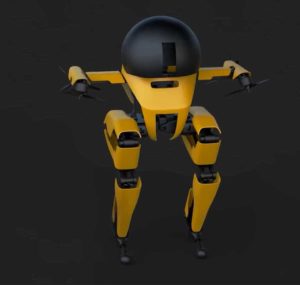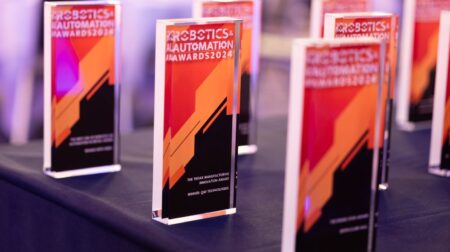Researchers from the California Institute of Technology (Caltec) have built a bipedal robot that combines walking with flying to create a new type of locomotion, making it nimble and capable of complex movements.
Part walking robot, part flying drone, the newly developed Leonardo (Legs onboard drone, Leo for short) can walk a slackline, hop, and ride a skateboard. Developed by a team at Caltech’s Centre for Autonomous Systems and Technologies, Leo is the first robot that uses multi-joint legs and propeller-based thrusters to achieve this degree of control over its balance.
Standing at 2.5 feet tall, Leo’s two legs have three actuated joints, along with four propeller thrusters mounted at an angle at the robot’s shoulders. The propellers are designed to ensure that the robot is upright as it walks. The leg actuators change the position of the legs to move the robot’s centre of mass forward through the use of a synchronised walking and flying controller. In flight, Leo uses its propellers alone and flies like a drone.
“We drew inspiration from nature. Think about the way birds are able to flap and hop to navigate telephone lines,” said Soon-Jo Chung, professor of aerospace and control and dynamical systems, Caltech.

“A complex yet intriguing behaviour happens as birds move between walking and flying. We wanted to understand and learn from that.
“There is a similarity between how a human wearing a jet suit controls their legs and feet when landing or taking off and how Leo uses synchronised control of distributed propeller-based thrusters and leg joints,” Chung added. “We wanted to study the interface of walking and flying from the dynamics and control standpoint.”
By using a hybrid movement that is somewhere between walking and flying, the researchers said they get the best of both worlds in terms of locomotion. Leo’s lightweight legs take stress off of its thrusters by supporting the bulk of the weight, but because the thrusters are controlled synchronously with leg joints, Leo has “uncanny” balance.
“Robots with a multimodal locomotion ability are able to move through challenging environments more efficiently than traditional robots by appropriately switching between their available means of movement. In particular, LEO aims to bridge the gap between the two disparate domains of aerial and bipedal locomotion that are not typically intertwined in existing robotic systems,” added Kyunam Kim, postdoctoral researcher at Caltech and co-lead author of the Science Robotics paper.
The team now plans to improve the performance of Leo by creating a more rigid leg design that is capable of supporting more of the robot’s weight and increasing the thrust force of the propellers. In addition, they hope to make Leo more autonomous so that the robot can understand how much of its weight is supported by legs and how much needs to be supported by propellers when walking on uneven terrain.
The researchers also plan to equip Leo with a newly developed drone landing control algorithm that utilises deep neural networks.







